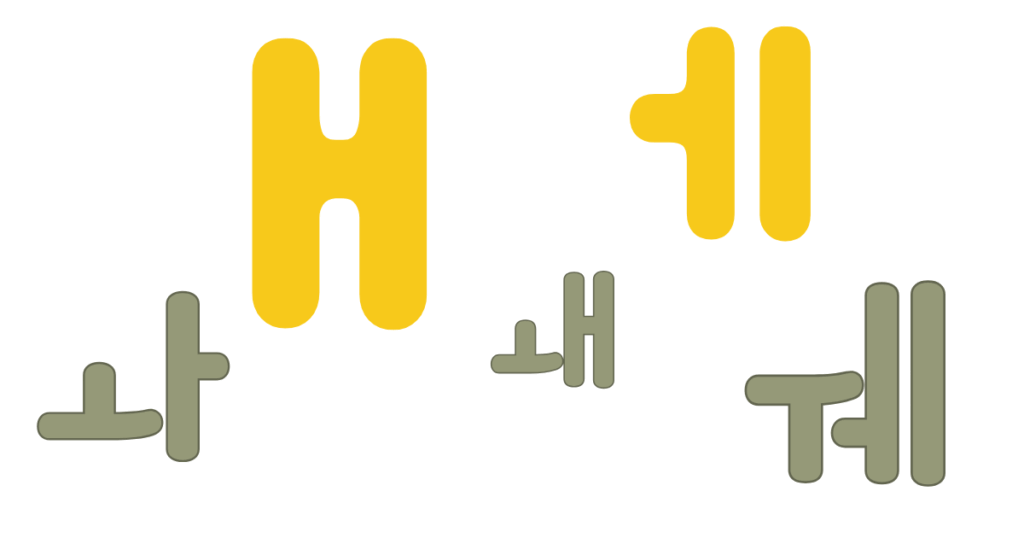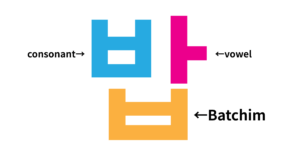Hello, this is Ayakim.
Today’s topic is all about double vowels in Korean.
In our last lesson, we looked at how Hangul, the Korean alphabet, is made.
If you haven’t read it yet, be sure to start here.
- Hangeul in 30 Minutes : A Beginner’s Guide to the Korean Alphabet
- Hangeul in 30 Minutes 2 : How to Read Korean Basic Vowels (with Writing Practice!)
Do Korean letters feel unfamiliar, hard to memorize, and maybe even exhausting to learn?
I get it.
But if you keep practicing over and over, you will remember them.
I’ve prepared a printable worksheet again this time, so let’s practice by writing them down and saying them out loud.
💌 Want more K-POP deep dives like this?
Subscribe to Hello Bias Letters, our free Substack newsletter!
Each week, we unpack K-POP culture with care—from fan behavior to behind-the-scenes stories.
→ Join us here
1. Introduction: What Are Double Vowels and Why Do They Matter?

Last time, we learned the 10 basic vowels:
Hangeul in 30 Minutes 2 : How to Read Korean Basic Vowels (with Writing Practice!)
Double vowels are simply vowels created by combining two of those basic vowels.
For example:
- ㅏ (a) + ㅣ (i) → ㅐ (ae)
- ㅗ (o) + ㅏ (a) → ㅘ (wa)
You might think, “That sounds completely different!”
But try reading ㅗ (o) and ㅏ (a) quickly together. It sound like ㅘ (wa) instead of “oa”.
Double vowels are not always just a direct “add and read” combination, but if you know the basic vowels, you can often predict them.
Today, we’ll review the basics while deepening our understanding of double vowels.
Double vowels appear very often.
For example, the word 사과 (apple) contains the double vowel ㅘ (wa).
You’ll see them in many basic words, so they’re unavoidable if you want to understand Korean.
If your goal is to truly understand Korean, the only way is forward!
2. How Double Vowels Are Made: Basic + Basic = New Sound
Double vowels (often called “compound vowels”) are made by combining two basic vowels to create a new sound. For example:
- ㅏ (a) + ㅣ (i) → ㅐ (ae)
- ㅗ (o) + ㅏ (a) → ㅘ (wa)
- ㅜ (u) + ㅣ (i) → ㅟ (wi)
They’re designed so the sound transitions smoothly, with quick changes in mouth shape and tongue position.
There are two main types:
1. Adding [ㅣ] for a smoother sound
- ㅏ (a) + ㅣ (i) = ㅐ (ae)
- ㅓ (eo) + ㅣ (i) = ㅔ (e)
- ㅑ (ya) + ㅣ (i) = ㅒ (yae)
- ㅕ (yeo) + ㅣ (i) = ㅖ (ye)
2. Combining [ㅗ] or [ㅜ] with another vowel for “w”-like sounds
- ㅗ (o) + ㅏ (a) = ㅘ (wa)
- ㅜ (u) + ㅓ (eo) = ㅝ (wo)
- ㅗ (o) + ㅣ (i) = ㅚ (oe) – often same as ㅙ
This type often has a subtle “w” or “y” sound at the start.
Double vowels can feel tricky at first, but if you know the basic vowels, you will get them. Practice while imagining the sound change in your head.
3. Meet the 11 Double Vowels

To be honest, understanding these sound changes from the start is hard for beginners.
Unless you have a strong “language sense,” you probably won’t fully get it right away.
Even I didn’t—so I just memorized all of them! 😅
The good news? There are only 11 double vowels.
It may take time, but repetition will make them stick.
🟡 11 Compound Vowels – Combinations & Pronunciation Tips
| Hangul letters and sounds | Combination: | Pronunciation: |
|---|---|---|
| ㅐ (ae) | ㅏ (a) + ㅣ (i) | Like “e” in bed (short e) |
| ㅒ (yae) | ㅑ (ya) + ㅣ (i) | Like “ye” in yes |
| ㅔ (e) | ㅓ (eo) + ㅣ (i) | Like “e” in bed ※ Very similar to ㅐ |
| ㅖ (ye) | ㅕ (yeo) + ㅣ (i) | Like “ye” in yes ※ Similar to ㅒ |
| ㅘ (wa) | ㅗ (o) + ㅏ (a) | Like “wa” in water |
| ㅙ (wae) | ㅗ (o) + ㅐ (ae) | Like “we” in wedding ※ Similar to ㅚ |
| ㅚ (oe) | ㅗ (o) + ㅣ (i) | Like “we” in wet or “way” ※ Often pronounced same as ㅙ |
| ㅝ (wo) | ㅜ (u) + ㅓ (eo) | Like “wo” in wonder |
| ㅞ (we) | ㅜ (u) + ㅔ (e) | Like “we” in wedding ※ Similar to ㅚ, ㅙ |
| ㅟ (wi) | ㅜ (u) + ㅣ (i) | Like “we” in week |
| ㅢ (ui) | ㅡ (eu) + ㅣ (i) | Unique sound. Starts like “eu” (ㅡ), ends with “i” (ㅣ). Sometimes pronounced as “i” in casual speech, especially after consonants. |
4. Practice: Write and Say the Double Vowels
Let’s practice writing the 11 double vowels.
When learning new words or letters, it’s more effective to combine four actions: seeing, hearing, writing, and pronouncing.
So don’t just look—write them down and say them out loud for better retention.
⬇️ Download the tracing practice sheet here! ⬇️
5. Mini Quiz: Can You Combine and Read These?
Part 1: Which Two Vowels Make This?
Q1. ㅐ
a. ㅏ + ㅣ b. ㅓ + ㅣ c. ㅗ + ㅣ
Q2. ㅘ
a. ㅗ + ㅏ b. ㅜ + ㅣ c. ㅓ + ㅏ
Q3. ㅚ
a. ㅗ + ㅐ b. ㅗ + ㅣ c. ㅜ + ㅔ
Q4. ㅟ
a. ㅜ + ㅓ b. ㅡ + ㅣ c. ㅜ + ㅣ
Part 2: Match the Sound with the Character
Q1. [wa]
a. ㅙ b. ㅘ c. ㅞ
Q2. [we]
a. ㅚ b. ㅟ c. ㅞ
Q3. [ui]
a. ㅢ b. ㅟ c. ㅣ
Part 3: Build the Vowel – Choose the Result
For each item, pick the resulting compound vowel.
Q1. ㅗ + ㅏ = ?
a. ㅘ b. ㅙ c. ㅚ
Q2. ㅗ + ㅐ = ?
a. ㅙ b. ㅞ c. ㅚ
Q3. ㅜ + ㅔ = ?
a. ㅝ b. ㅞ c. ㅟ
Q4. ㅜ + ㅣ = ?
a. ㅟ b. ㅚ c. ㅢ
Q5. ㅜ + ㅓ = ?
a. ㅝ b. ㅚ c. ㅘ
Q6. ㅡ + ㅣ = ?
a. ㅢ b. ㅙ c. ㅞ
Q7. Which one matches the romanization “oe”?
a. ㅚ b. ㅞ c. ㅙ
📝 Answer Key
Part 1: Which Two Vowels Make This?
Q1. ㅐ → a. ㅏ + ㅣ (ae)
Q2. ㅘ → a. ㅗ + ㅏ (wa)
Q3. ㅚ → b. ㅗ + ㅣ (oe)
Q4. ㅟ → c. ㅜ + ㅣ (wi)
Part 2: Match the Sound with the Character
Q1. [wa] → b. ㅘ (wa)
Q2. [we] → c. ㅞ (we)
Q3. [ui] → a. ㅢ (ui)
Part 3: Build the Vowel – Choose the Result
Q1 → a. ㅘ (wa)
Q2 → a. ㅙ (wae)
Q3 → b. ㅞ (we)
Q4 → a. ㅟ (wi)
Q5 → a. ㅝ (wo)
Q6 → a. ㅢ (ui)
Q7 → a. ㅚ (oe)
6. Let’s Try Some Real Korean Words with Double Vowels
Today, let’s learn 18 basic words that use double vowels.
You can also use the tracing worksheet for extra practice.
| Words and sounds: | Meaning: | Structure: |
|---|---|---|
| 과일 (gwail) | Fruit | ㄱ + ㅗ + ㅏ + ㅇ + ㅣ + ㄹ |
| 사과 (sagwa) | Apple | ㅅ + ㅏ + ㄱ + ㅗ + ㅏ |
| 좋아요 (joayo) | Good / Like | ㅈ + ㅗ + ㅎ + ㅏ + ㅇ + ㅛ |
| 왜 (wae) | Why | ㅇ + ㅗ + ㅐ |
| 회사 (hoesa) | Company | ㅎ + ㅗ + ㅐ + ㅅ + ㅏ |
| 외국 (oeguk) | Foreign country | ㅇ + ㅗ + ㅔ + ㄱ + ㅜ + ㄱ |
| 괜찮아요 (gwaenchanayo) | It’s okay | ㄱ + ㅗ + ㅐ + ㄴ + ㅊ + ㅏ + ㄴ + ㅏ + ㅇ + ㅛ |
| 되다 (doeda) | To become | ㄷ + ㅗ + ㅔ + ㄷ + ㅏ |
| 뇌 (noe) | Brain | ㄴ + ㅗ + ㅔ |
| 뭐 (mwo) | What | ㅁ + ㅜ + ㅓ |
| 원 (won) | Won (currency) | ㅇ + ㅜ + ㅓ + ㄴ |
| 원하다 (wonhada) | To want | ㅇ + ㅜ + ㅓ + ㄴ + ㅎ + ㅏ + ㄷ + ㅏ |
| 위 (wi) | Above | ㅇ + ㅜ + ㅣ |
| 의사 (uisa) | Doctor | ㅇ + ㅡ + ㅣ + ㅅ + ㅏ |
| 웨딩 (weding) | Wedding | ㅇ + ㅜ + ㅔ + ㄷ + ㅣ + ㅇ |
| 귀 (gwi) | Ear | ㄱ + ㅜ + ㅣ |
| 위험하다 (wiheomhada) | Dangerous | ㅇ + ㅜ + ㅣ + ㅎ + ㅓ + ㅁ + ㅎ + ㅏ + ㄷ + ㅏ |
| 퀴즈 (kwijeu) | Quiz | ㅋ + ㅜ + ㅣ + ㅈ + ㅡ |
⬇️ Download the tracing practice sheet here! ⬇️
7.Coming Up Next: Consonants and Beyond!
That’s it for the vowels — you did a great job! 🎉
Don’t worry if you don’t remember every single one right now.
The important thing is that you’ve seen them all and started getting familiar with Hangul.
Next time, we’ll move on to consonants (자음) and learn how vowels and consonants work together to build complete syllables.
💬 If you found this post helpful, consider supporting me with a coffee!
Your support keeps Hello Bias going ☕💛
👉 Buy Me a Coffee








